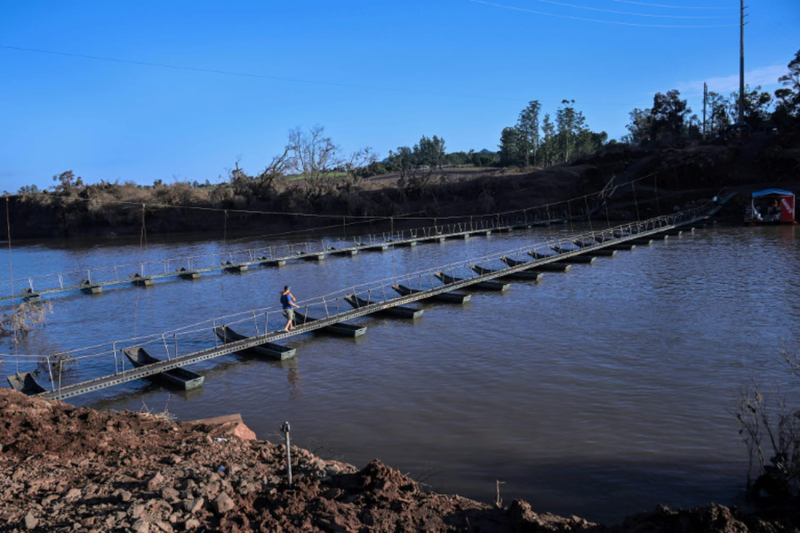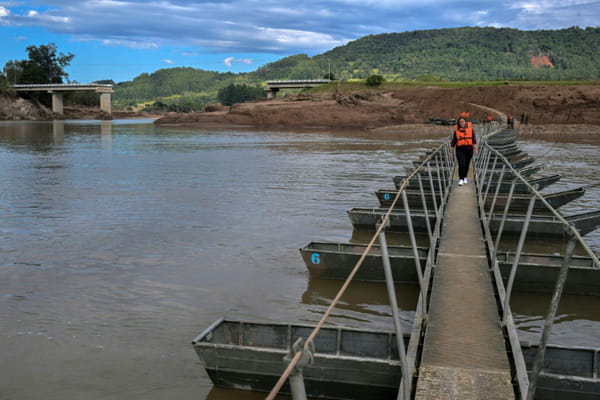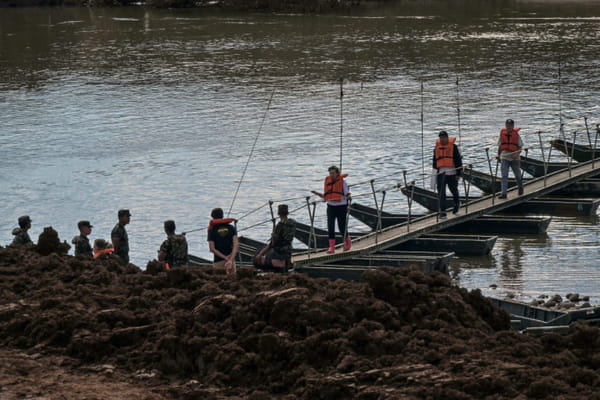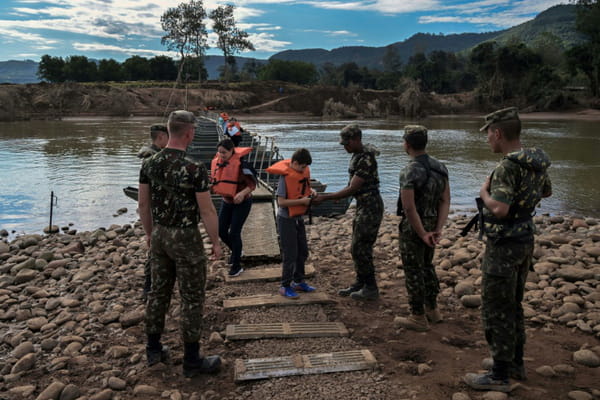With his calf bandaged, Paulo Roberto Heineck limps forward on a floating footbridge. This temporary bridge was built. installed by the army to break the isolation of rural localities in southern Brazil hit by devastating floods. The 54-year-old mason who recently had surgery has no choice: he must go to his doctor. “Everything is more difficult now, but we must move forward,” sighs this father of three children. Using these footbridges is the only way to connect the neighboring towns of Travesseiro and Marques de Souza, after the destruction of bridges swept away by the flood of the Forqueta, one of the rivers which cross the Taquari Valley. This agricultural region was one of the most affected by the unprecedented floods which devastated the State of Rio Grande do Sul, leaving nearly 170 dead and several dozen missing. People cross the Forqueta River on a floating footbridge, in Lajeado, Brazil, May 21, 2024 © AFP – Nelson ALMEIDA At least six bridges were destroyed in this area located northwest of the regional capital Porto Alegre, preventing many residents from traveling by car from one municipality to another, to work, go to school or home. the doctor. To avoid being totally cut off from the world, they must use floating footbridges like those used by the military in times of war to cross rivers afterwards the bombing of bridges. But these footbridges are as essential as they are precarious: with each new bad weather, they risk being swept away by the current, forcing the authorities to install them news. – In single file – “The population had to be able to resume their usual habits as quickly as possible. as quickly as possible,” explains Colonel Rafael Farias, 46 years old. This is why the army has temporarily installed around five footbridges in the Taquari Valley. People cross the Forqueta River on a floating footbridge, in Lajeado, Brazil, May 21, 2024 © AFP – Nelson ALMEIDA These narrow metal bridges rest on floating structures that resemble canoes arranged a few meters apart across the width of the river. To borrow them, you have to walk in single file and wearing a life jacket – distributed by soldiers posted on each bank – is obligatory. Juliani Steffer, seller of clothes of 36 years old, arrives out of breath on the other bank, after carrying a bag full of goods. “People have lost a lot of clothes. As they cannot can't come to my shop by car, I go to their house”, she says. Due to a lack of lighting, the footbridge has to close at dusk, which forces residents to return early so as not to risk being stuck on the other bank. And the crossing is sometimes simply impossible: the footbridge that take Paulo Roberto Heineck and Juliani Steffer to connect Travesseiro to Marques de Souza had to be withdrawn twice, the last on Tuesday, due to a strong current. – Mobilization – A similar problem affected two other important footbridges, installed side by side to connect the localities of Arroio do Meio and Lajeado, the largest town in the Taquari Valley, with its 90,000 inhabitants. Thousands of motorists had gotten into the habit of parking on either side to access the neighboring town on foot. But these footbridges were damaged on May 23 by violent rainfall. New footbridges began to be installed on Wednesday, the army told AFP. Soldiers recover life jackets used by people who crossed the Forqueta River on a floating footbridge, May 21, 2024, in Lajeado, Brazil © AFP – Nelson ALMEIDA In the meantime, residents had to cross the river on boats provided by the military and volunteers, carrying only 25 people per trip. The floating footbridges “are fundamental, because Arroio do Meio does not live without Lajeado and vice versa”, judges Marta Rosani da Silva, a 41-year-old street sweeper who is waiting to make the crossing with her child. She hopes that the car bridges will be rebuilt soon. “Before, it took us an hour to get to work, now it takes three hours.” The federal government has promised to fund the reconstruction of the bridges, but residents are mobilized to obtain additional funds from the private sector. For the Travesseiro bridge, the estimated cost amounts to 10 million reais (approximately 1.8 million euros). “The authorities promised us four million, we are still missing six,” calculates Cristina Lammers, 44, entrepreneur in the food industry. All rights of reproduction and representation reserved. © (2024) Agence France-Presse




